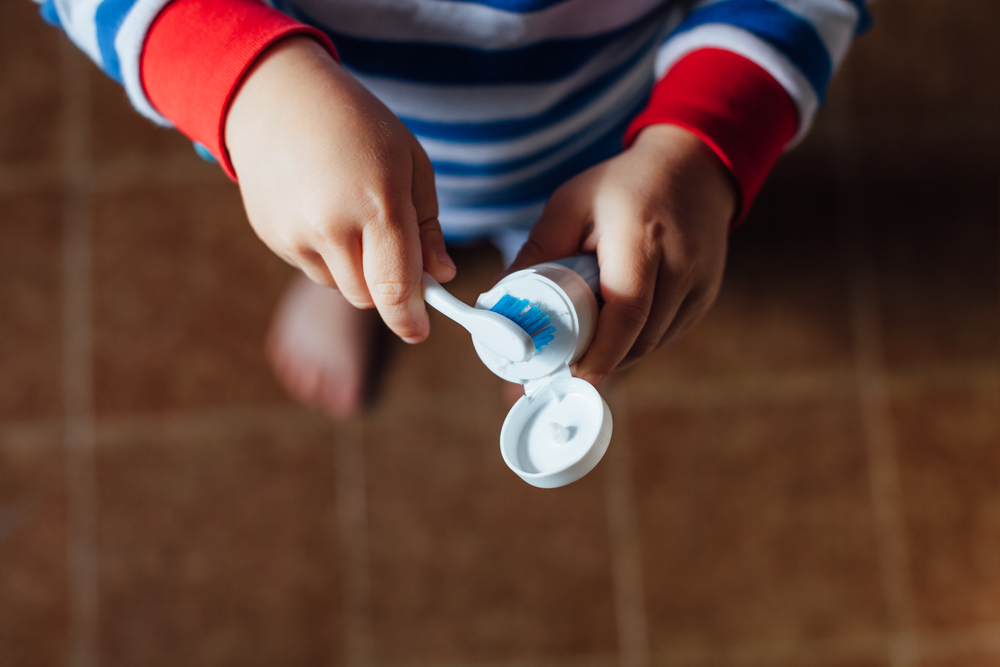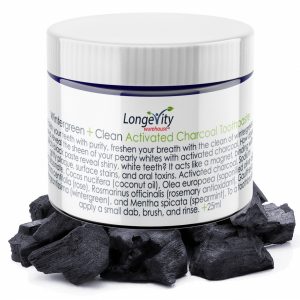
What’s Lurking in Your Toothpaste?
When cruising down the toothpaste aisle looking for a new tube, most people don’t stop to read the ingredients.
Instead, they are looking for specific features: Which one is the best to whiten teeth? Freshen breath? Remove plaque?
Knowing what ingredients are in your toothpaste, however, is critically important. The inside of your mouth is one of the most absorptive places of your body. What you scrub your teeth with actually affects every inch of you!
Have you ever taken a medication that came with specific directions to squirt under the tongue? This is because the medication enters your body faster through the thin mucosa of the mouth, traveling directly into your bloodstream. The same action that quickly drives medication in, spreads the ingredients of your toothpaste into every system, organ, and cell of your body.
You may be thinking, “I use such a small amount of toothpaste each time I brush, it’s probably not a big deal…”
It actually is.
The average American uses 20 GALLONS of toothpaste in his/her lifetime! That’s 20 gallons worth of ingredients being injected directly into your body. When you consider the amount of unhealthy ingredients in the majority of toothpastes on the market – and that many of these toxic chemical ingredients build in your system – what you use on your teeth and gums, matters.
Toothpaste wasn’t always Toxic
The oldest recipe we know of for mouth cleaning dates back between 3,000-5,000 AD in Egypt. The Egyptians created a dental cream from powdered oxen hooves ashes, myrrh, egg shells, and pumice to remove particles of food from their teeth. The Greeks and Romans expanded on this recipe by adding more abrasives – crushed bones and oyster shells – and charcoal and bark to combat bad breath. The Egyptians later developed the first toothpaste, which was a powder that mixed with saliva in the mouth to form a paste. The powder was made up of mint, salt, pepper granules, and dried iris flower.
In the early 1700s, tooth powders were very popular although the ingredients shifted to include brick dust, crushed china, earthenware, cuttlefish, dragon’s blood resin, and even burnt bread. By the end of the 1700s, baking soda was the primary ingredient in most tooth powders and by the end of the 18th century borax powder had been added to create a “foaming effect” along with glycerin to make it more palatable and to stop the paste from drying out.
In 1824, soap was added to toothpaste for extra cleaning powder and in 1873 Colgate & Co. presented the first mass-produced toothpaste in a jar. 1892 saw the first collapsible toothpaste tube hit the market, and as the 1900s began, Pepsodent created an advertising campaign (minty and frothy!) that ingrained the “habit” of brushing teeth within all American households.
It was from this point forward that toothpaste started taking on more and more hazardous ingredients. Fluoride was introduced in 1914, chemical disinfectants in 1937, synthetic surfactants like sodium lauryl sulfate (SLS) in 1945, chemical-based whiteners in 1945, and the list goes on.
Toothpaste in 2018 reads like a chemistry experiment. Unfortunately, the majority of people who brush two-to-three times daily have no idea what’s foaming up in their mouth.
Toothpaste’s Terrible Ingredients
Truly, there are too many toxic ingredients in modern-day toothpastes to discuss them all. So here are just five of the most harmful ones for you to consider.
1 – Fluoride
This controversial ingredient was once revered as the end-all, be-all in cavity prevention. Unfortunately, over years of use and scientific testing, fluoride has been proven to do more harm than good, especially for children.
Fluoride has been called a “cumulative toxin” and causes fluorosis when absorbed in high quantities. It affects bone mineral metabolism and impairs bone collagen synthesis. In the mouth, it’s mainly identified by white streaks or spots on the teeth, or by small opaque areas on the teeth. It can also manifest as brown stains or pitted enamel.
Fluoridated water, toothpaste, or mouthwash when swallowed accumulate in your body tissues. It can cause enzyme imbalances, neurological symptoms, endocrine dysfunction, chronic joint pain, bone lesions, osteosclerosis, osteomalacia, and osteoporosis.
The kicker is, fluoride doesn’t even provide the protection it claims. The amount of fluoride in toothpaste creates a 6 nanometer thick layer on your teeth, which is broken as soon as you chew. To put that in perspective, you’d need 10,000 of these layers to create a coating the thickness of ONE of your hairs. Yet everytime you brush, you’re storing more fluoride in your system.
Fluorosis is irreversible and based on the health ramifications and lack of true protection, this is one ingredient you should absolutely avoid.
2 – Sodium Lauryl Sulfate (SLS, SLES)
Added for its ability to make toothpaste foam and for its supposed cleansing ability, SLS poses a number of health concerns ranging from drying out the mouth, causing canker sores, irritating allergies, and interfering with the functioning of taste buds. It’s actually classified as an insecticide that can damage eyes, skin, and cause labored breathing. Even worse, the way SLS is processed releases carcinogenic volatile organic compounds (VOCs) into our environment and potentially contaminates the SLS with 1,4 dioxane, a carcinogenic byproduct.
Sodium lauryl sulfate can stay within the body for up to five days, accumulating in the heart, liver, lungs and brain, according to The American College of Toxicology. In addition, it has the ability to transform into nitrosamines, when it comes into contact with other chemicals, to form a class of powerful carcinogens that allow the body to absorb nitrates – more harmful substances.
If you start looking at the labels of your beauty products, soaps, and shampoos, you’ll probably notice SLS listed in most of them, which increases your exposure level even further.
3 – Diethanolamine (DEA)
DEA is listed by The California Environmental Protection Agency as a possible human carcinogen. It is a known hormone disruptor and can react with other ingredients to form N-nitrosodiethanolamine (NDEA), a potential carcinogen, which has been linked with stomach, esophagus, liver, and bladder cancers.
The cosmetic database put together by the Environmental Working Group (EWG) gives DEA a top ranking toxicity score of 10/10 due to its ability to cause organ system toxicity and its moderate cancer-causing risk.
Similar to SLS there are concerns of contamination during processing. It’s an ingredient that should be avoided at all costs, not rubbed into your teeth and gums every day!
4 – Triclosan
Triclosan is an antibacterial chemical found in hand soap, cosmetics, and toothpaste that has been shown to help prevent gingivitis. Colgate Total flaunts itself as the “only toothpaste approved by the FDA to help fight plaque and gingivitis.” In fact, it is such an effective delivery method for triclosan that urine testing shows people who brush with Colgate Total have more than five times the triclosan in their body as those who did not.
The bad news? Triclosan is an endocrine-disrupting ingredient. It can promote many types of cancers, affect birth weights and gestation periods of babies, spark early puberty in girls, and cause undescended testicles in boys. Animal studies are showing that triclosan may promote breast cancer progression, fetal bone malformations, and interfere with cell signaling throughout the body.
5 – Aspartame
Arguments claiming aspartame is a safe sweetener are incredibly dangerous to your health. Primarily made of up of aspartic acid and phenylalanine, the problem is with the extra methyl group the phenylalanine has been modified to carry. (The extra methyl group is what offers most of the sweetness of aspartame.) The bond attaching the extra methyl group is very weak and breaks off easily, which then forms methanol.
Methanol, supporters of aspartame argue, is found in fruits and vegetables and so what’s the problem? Within fruits and vegetables, the methanol is bonded to pectin and doesn’t break off. It’s carried out of the body safely attached to the pectin. When methanol floats around on its own, your body can’t break it down or detox it out of your body. Instead, it travels through your bloodstream into your brain and organs where it’s converted to formaldehyde.
Formaldehyde is incredibly hazardous and along with Diethanolamine (mentioned above) is listed as a 10 on the EWG website due to the fact that it’s a known human carcinogen. It can also cause headaches, dizziness, nausea, intestinal upset, chills, memory problems, numbness or pain in the extremities, and behavior changes.
What’s a Person to Do?
Making a shift in your oral care means going against the ingrained notion that toothpaste should come in a squeezable tube and be available at any drugstore you stop at.
Returning to your roots and taking a nod from your ancestor’s mouth care ingredients to reduce systemic toxicity needs to be a priority when you consider your overall health and longevity.
Activated charcoal, coconut oil, and essential oils can clean your mouth better than any laboratory-created concoction while maintaining the proper pH, supporting a healthy bioterrain, naturally whitening your teeth, and eliminating bad breath.
We encourage you to clean your mouth in a better way! By using ingredients nature has provided us with we can have the pearly white, cavity-free teeth we strive for – without causing chronic disease.
Longevity Warehouse® Activated Charcoal Toothpaste is a combination of antiseptic botanicals and oils mixed with detoxifying charcoal to create a completely natural toothpaste that actually works better than any of the factory-created ones.
- Whiten Teeth
- Erase Surface Stains
- Destroy Toxins
- Freshen Breath
- Cultivate Healthy Gums
- Chemical and Preservative FREE
Snag your container and learn more about Activated Charcoal Toothpaste HERE.
References:
Speareducation.com, November 2012
UC Davis, Anti-bacterial Personal Hygiene Products
Langmuir. 2010 Dec 21;26 (24):18750-9
Fluoride Action Network August 2012
Camden Haven Courier September 23, 2014
Chem. Res. Toxicol., 2014, 27 (5), pp 834–842
Compend Contin Educ Dent., 1997, pp 1238-40.





+ There are no comments
Add yours